Hakata Old Town Area (Photogenic Course)
Just minutes from Hakata Station, the Hakata Old Town area features many temples and older neighborhoods. This area contains countless photogenic locations for people who like to stumble upon new discoveries. Experience medieval Hakata at your own pace. Who knows, you might even find your own photogenic spots no one else knows about!
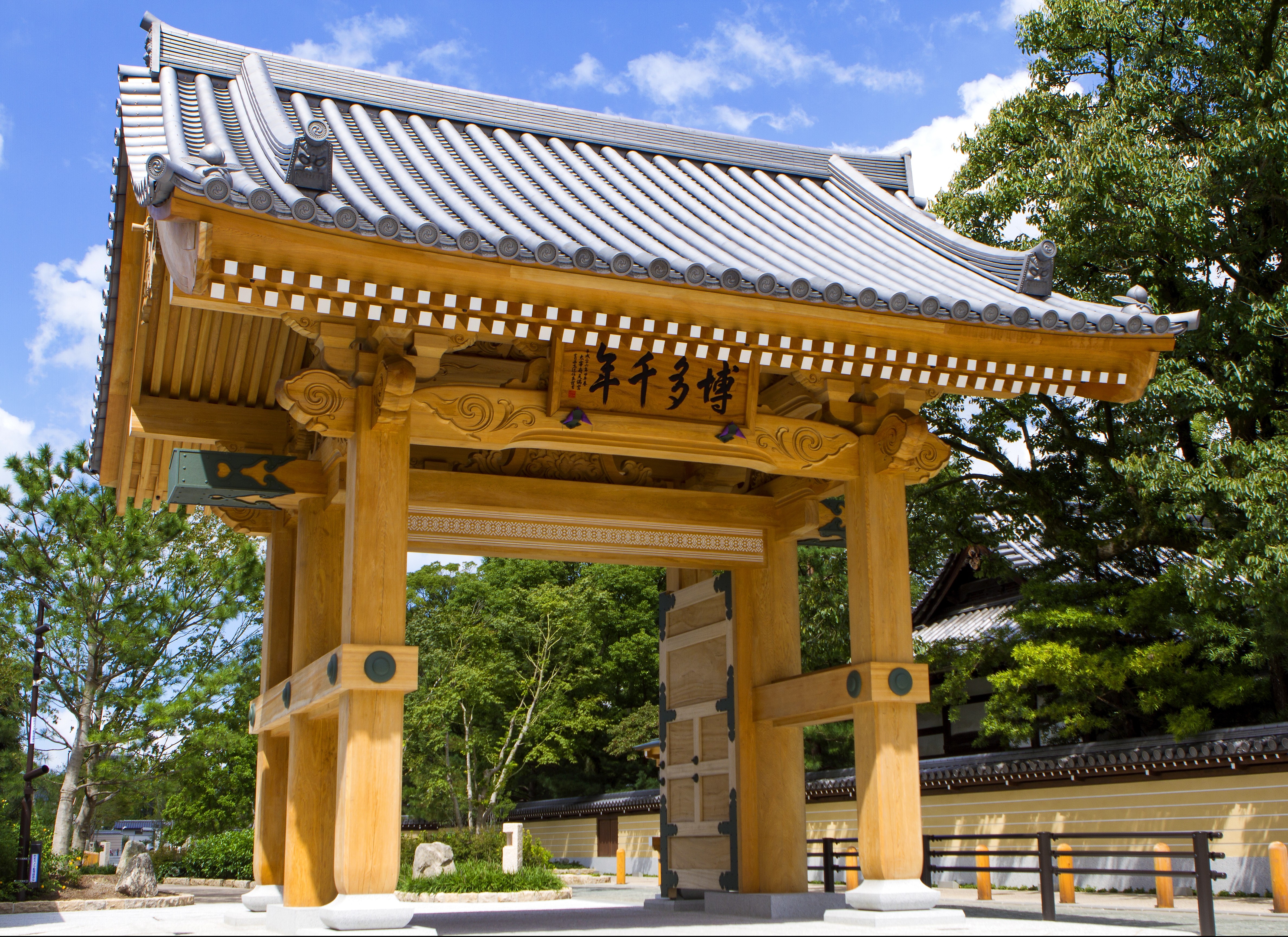
Hakata Sennen-no Mon
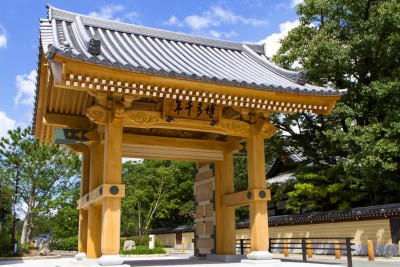
The Hakata Sennen-no Mon, completed in March 2014, serves to welcome visitors to the Temple Town. The gate was named to recognize the accumulated history of Hakata, and to pray for continued prosperity for the next 1,000 years. Along with its solemn presence, the gate is filled with details representative of the Hakata, such as the thousand year camphor used, donated by the Dazaifu Tenmangu Shrine, and for the transom, the carved openwork featuring patterns from the kenjo-gara style of local Hakata textiles.
Points of interest for photographers: the plum-shaped roof tiles on the Hakata Sennen-no-mon Gate and the stone paving on Jotenji Street.
- Address
- Jotenji Street, Hakataekimae 1-chome, Hakata-ku, Fukuoka City
- Details
- YokaNavi Spot Information
Myorakuji
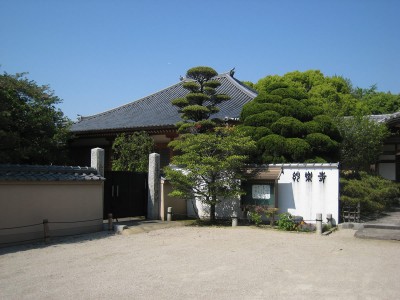
This is the temple of the Rinzai school Daitokuji Sect of Buddhism, built by Getsudo Soki in 1316. Originally, this temple was located along the sea, and was called Okinohama.
The temple was lost in a fire during the Tensho Period (1573-1591). It was moved to its present location after Kuroda Nagamasa, the first lord of the old Fukuoka Domain, started reigning in the area. The temple graveyard contains the tombs of Kuroda Nagamasa, as well as the tomb of Kamiya Sotan, the renowned merchant of Hakata in the Edo Period, and the tombs of the vassals who served the Kuroda Family.
Myorakuji is also well known as the first place to have produced Uiro, a popular local Japanese sweet.
Points of interest for photographers: The demon-shaped roof tiles, the monument declaring the location the birthplace of Uiro, and the nearby Hakata-bei walls (a type of mud wall unique to Hakata).
- Address
- 13-6, Gokusho-machi, Hakata-ku, Fukuoka
- Details
- YokaNavi Spot Information
Shofukuji
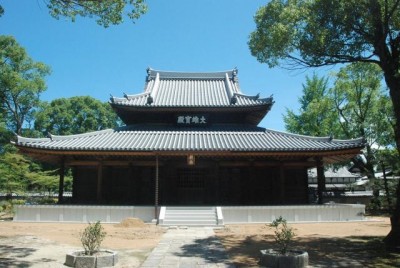
Shofukuji Temple, famous as Japan’s first true Zen temple, was established in 1195, the 6th year of the Kenkyu era, by Myoan Eisai, a Buddhist priest who was the founder of the Rinzai school of Zen Buddhism in Japan. The temple is also known as the birthplace of Japanese green tea, and the temple grounds feature tea plants (Camellia sinensis) from which the tea is made. The temple grounds, designated a national historical site, are a well preserved example of the “garan” layout of Zen temples, with the sanmon gate, Buddhist sanctum, and main hall arrayed in a straight line. The grounds are also filled with natural greenery, providing a soothing sense of being in a forest.
Points of interest for photographers: The nearby Hakata-bei walls (a type of mud wall unique to Hakata.)
- Address
- 6-1 Gokushomachi, Hakata-ku, Fukuoka City
- Details
- YokaNavi Spot Information
Tochoji Temple
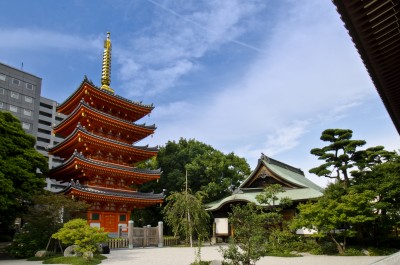
The Fukuoka Great Buddha enshrined at Tochoji Temple is Japan’s largest wooden statue of a seated Buddha at 10.8 meters in height. The statue’s nimbus features two rows of 7 and 13 Buddha images, with a further 5,000 small Buddha images on the wall to the back, creating a very impressive presence. There is also an opening in the base of the statue representing the path from hell to heaven. The pathway inside, decorated in “hell picture scrolls”, leads into darkness. If one uses the handrails to proceed further, they will find an image of heaven at the end bathed in a subtle light. It is said that touching the Buddha ring mid route will enable one to enter heaven.
The temple also boasts other attractions that evoke a sense of both distant and recent history, such as the unique revolving hexagonal hall and the five story pagoda completed in 2011 after 37 years of construction.
Points of interest for Photographers: The five-story pagoda, and the giant prayer bead necklace hung by a pulley system.
- Address
- 2-4, Gokusho-machi, Hakata-ku, Fukuoka
- Details
- YokaNavi Spot Information
Kushida Shrine
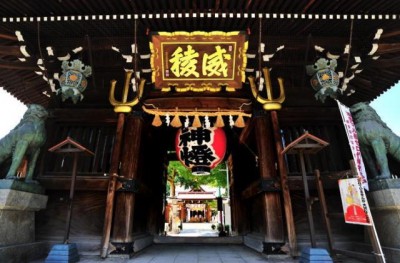
This grand tutelary shrine of Hakata is widely known and people warmly refer to it as “Okushida-san.”
It is dedicated to the gods of Ohatanushi-no-mikoto, Amaterasu-omikami and Susanowo-no-mikoto. According to tradition, in 757, when Emperor Koken was in the reign and Tairano Kiyomori designated Hakata port as a base of Japan-China trade, the shrine was built on the emperor’s order to share a god with Kushida shrine of Ise province (the present Mie prefecture).
In 1585 during the Hakata restoration, Toyotomi Hideyoshi contributed to rebuild the current main building of the shrine.
Hakata Gion Yamakasa festival, widely known as a summer feature of Hakata, is dedicated to this shrine.
Point of interest for photographers: The decorated "Yamakasa" festival float.
- Address
- 1-41, Kamikawabata-machi, Hakata-ku, Fukuoka
- Details
- YokaNavi Spot Information
Fukuoka Asian Art Museum
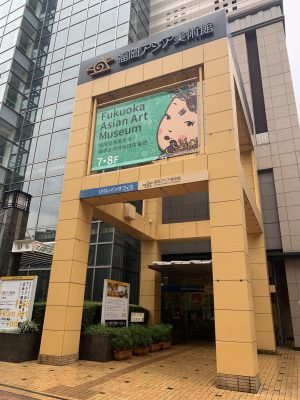
You can enjoy looking at contemporary art works from all Asia here at Hakata Riverain! The museum exhibits 2,900 art pieces collected from 23 different countries and regions in Asia. Not only exhibitions but also workshops by the artists invited from Asian countries are held. The souvenir shop at the museum carries a variety of original goods, exhibition related books, attractive Asian accessories and furnishing products.
Points of interest for photographers: The gallery on the first floor, and the art café on the seventh floor.
- Address
- Riverain Center bldg. 7 & 8F, 3-1, Shimo Kawabata-machi, Hakata-ku, Fukuoka
- Details
- YokaNavi Spot Information